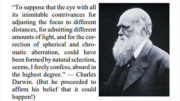Dr Joe Francis | Answers in Genesis
Bacteria depend on tail-like structures called flagella to get around. But they’re not alone. Every creature, including most cells in your body, depends on similar structures to survive.
Inside your body are trillions of little hair-like whips attached to most of your cells. They are constantly moving, pushing debris out of your body and sensing the world around them. A couple of centuries ago, biologists assumed they were useless remnants of bacterial evolution. Now medical researchers have found those ideas were dead wrong. These structures are essential for life and are found in virtually every organism—from algae and plants to reptiles and mammals.
The complexity of these structures, which contain functional motors, astounds evolutionists, who cannot explain how so many intricate, interacting parts could arise together. Yet they remain doggedly certain an answer is within reach. Just one problem—they also have to explain how these motors adopted such different essential roles within each creature on the planet! How could creatures survive the development of critical systems by trial and error?
There is a logical explanation. From the beginning, an infinitely wise Creator and Life-giver designed these systems so He would be “clearly seen” in the things He has made (Romans 1:18).
Two Different Motors
Ever since biochemist Michael Behe wrote Darwin’s Black Box in 1996, the whip-like appendage on bacteria, called the flagellum (plural flagella), has taken center stage in debates about the origin of life. But the debate gives the mistaken impression that the flagellum is a single type of machine that basically helps bacteria move around. This could not be further from the truth.
No gradual evolutionary process can explain the various functions among cilia.
Flagella belong to a larger group of structures, and they are not all the same. Under a microscope your cells and bacteria might look similar on the outside, but the internal parts can be very different, and the way they are built is different, too.
In fact, evolutionary biologists now admit that these types of complex machines are so different that one could not have evolved from the other. Both designs must have been created by God in the beginning, since all creatures today have inherited one or the other design.
Bacterial Flagellum
The bacterial flagellum is a long, spinning, whip-like structure that pokes through the membrane and cell wall and moves like the propeller on a boat (Figure 1). Bacteria construct these flagella by building a motor inside the cell. They then attach the motor to the whip, which is made by sending proteins outside the cell. Once complete, its shape and design won’t change.
Cilium
The other main type of whip-like organelle looks a lot like a bacterial flagellum, and (confusingly) it can also be called a flagellum. But it is very different. Another name for this structure is the cilium (plural cilia). To avoid confusion, we will call it that. Bacteria don’t have cilia, and other organisms don’t have the bacteria’s flagellum.
Cilia are not rotary engines but motorized machines made of nine sliding cables (called filaments) located underneath the cilia’s membrane (Figure 2). The filaments slide up and down inside the cilium, causing it to bend back and forth like a bendable paddle. Paddle locomotion is completely different from the rotary movement of a bacterial flagellum.
Cilia are not built the same way as bacterial flagella, either. They require very different proteins that work inside the cell rather than outside, and the proteins remain at work throughout the life of the cell, constantly changing the cilia’s length.




